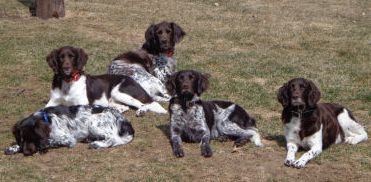 |
HISTORY OF THE BREED
The Small Munsterlander Pointer, one of the four original versatile hunting breeds, is a wonderful all-around gun dog and household companion. The Munster (pronunciation: 'mün-st r)(loosely: 'moon-stur) can efficiently carry out the duties of a pointer and retriever of both fur and feathered game from land or water. r)(loosely: 'moon-stur) can efficiently carry out the duties of a pointer and retriever of both fur and feathered game from land or water.
|
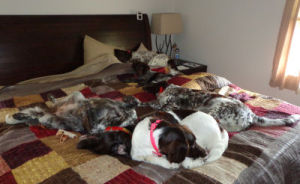 With an increase in the number of hunters and hunting enthusiasts, and the systematic cultivation of game stock resulting from a change in the German hunting laws during the middle of the 19th century, the breeding of new German pointing dogs began. There are reports saying that around 1870 long-coated Wachtelhunds (German Spaniels) were well known in the Munsterland region. These dogs were firm in pointing; had enormous scenting abilities; and were also able to retrieve. In 1906, the well-known poet, Hermann L ns, made a public appeal in the magazine Unser Wachtelhund to give him a report on the still existing specimens of the red Hanovarian Heath Hound. As a result, he and his brothers discovered a pointing Wachtelhund they called Heidewachtel. The L ns brothers and other well-known dog breeders, like the Baron of Beverv rde-Lohburg, put efforts into getting Heidewachtel breeding stock into other regions in Germany as well. Mr. Heitmann, a teacher from Burgsteinfurt, achieved first success with his line breeding. Several other lines, known as the so-called 'Dorsten type', appeared during the following years in Westphalia. On March 17, 1912, the Verband f r Kleine M nsterl nder Vorstehhunde (Club for Small Munsterlander Pointing Dogs) was finally founded. At that time, the Club expressed its aims as follows: "The Club pursues the purpose to promote the purity and the true breeding of the long-coated small pointing dog that has been bred in the Munsterland for many decades." A lack of fixed breed characteristics at that time inhibited breeding activities as well as Club activities. Starting in 1921, breeders finally began to follow the breed standard drawn up by Mr. Friedrich Jungklaus. Nevertheless, the true origin of the Small Munsterlander Pointing Dogs has not been proved. [ Read more about the history and origin of the Small Munsterlander Pointer.] 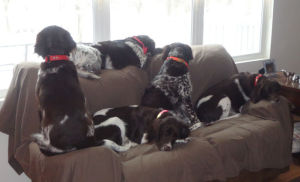 In addition to being a tireless hunter and tracker, the Munster was developed to double as the family pet and watchdog. The Munsters of today do far more than just hunt. Because of their high intelligence, cooperative nature and calm demeanor, Munsters are also being used as Therapy/Assistance Dogs. SIZE & WEIGHTAccording to the International Breed Standard for the Small Munsterlander, a Munster male should be 52cm-56cm (roughly 20.50"-22") tall at the withers (points of the shoulder blades). A female should be 50cm-54cm (roughly 19.75"-21.25") tall. Munsters males generally weigh between 45-55lb and females between 40-50lb. The weight for two dogs of roughly the same height can vary considerably, depending upon each dog's body condition and build. The Munster is an athlete, so should be kept in lean and muscular body condition. However, a Munster should have a build more like a truck than a bicycle. The Breed Standard calls for "strong and harmonious build of medium size, showing balanced proportions with a lot of quality and elegance." The Standard calls for every aspect of a Munster's body to be strong and muscular, with good angles, and strong bone. USA-born Munsters, in general, had become too small and slightly built when we started breeding in the early 2000's. We worked hard to improve this in the Brush Dale line and, today, Brush Dale dogs meet the Breed Standard.
COLORS & MARKINGSThere is no color/marking of Munster that is more desirable nor valuable than another. The Breed Standard requires Munsters be a combination of brown and white in color with a white-tipped tail. Solid-colored Munsters have an eliminating fault and therefore cannot be bred. Some are a milk chocolate brown and some are a dark chocolate brown. Some are so dark brown they almost look black. Reddish-brown is improper, but occasionally seen. There is a rarely seen coloring exception dating back to one of the Breed's founders called "Jungklaus Markings." These are tan markings, typically on the muzzle/cheeks, eyebrows, legs, and around the anus. Kimber's AA Litter has three puppies with these markings.
Munsters come in two defined colors: Roan and Brown & White. They are equally common colors, but recently the roan color seems to have increased in popularity, despite being more difficult to see in the cover while upland hunting. Roan Munsters are white dogs with brown patches and a lot of brown ticking. Roan Munsters can be a lighter roan, where there are approximately equal amounts of brown and white in the ticking. With a darker roan Munster, there is more brown than white in the ticking. Brown & White Munsters are white dogs with brown patches and some brown speckling in the white areas, especially on the legs. Brown & White Munsters generally have the most feathering, especially on their tails. Brown & White Munsters are popular with Ruffed Grouse and Woodcock hunters because of their easier visibility in wooded cover.
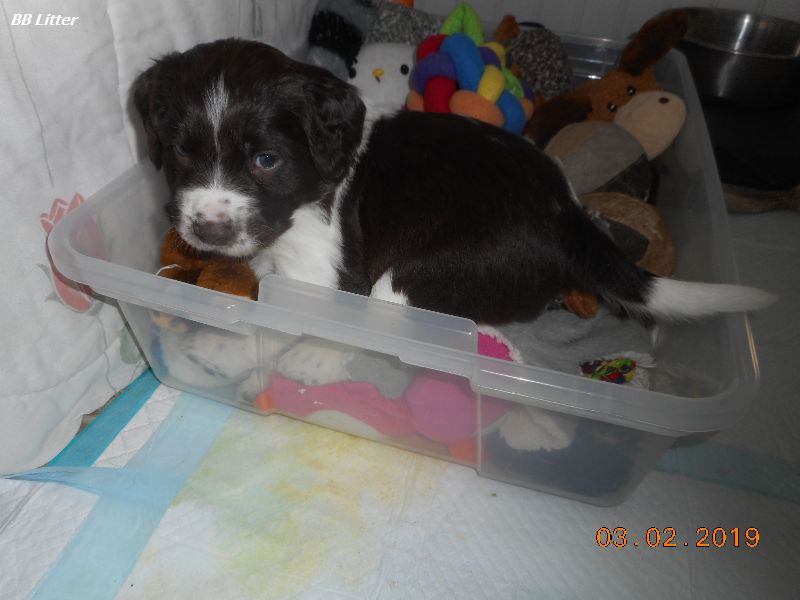 A Munster's head can be solid brown or have a blaze. A blaze is most often seen on the forehead, but sometimes extends down and around the muzzle. The blaze can be slight or prominent. A prominent blaze comes from the Spaniel influence in the breed. Spaniels were used to give the Munster its beautiful feathering and much of its head/facial features. This is why people often mistake Munsters for Springer Spaniels. In roan Munsters, the blaze often develops so much ticking that it becomes hard to distinguish from solid brown. A little bit of whitish coloring on the tip of the nose is common in roan Munster puppies and is lovingly called "fairy dust." As the puppy's coat matures, the fairy dust most often all but disappears. Many Munsters have a white patch under their chin. Rare Colors/Markings: The rarest marking is a Munster with Jungklaus Markings. This marking may have been fairly common when the Breed was first being developed, but today you will likely never see a Munster with Jungklaus Markings in real life. Originally, the most common coloring/marking combination was Brown & White with a prominent blaze on the forehead and muzzle. Today, it is one of the rarest at about 10%-15% of Munsters. Claire has this coloring/marking combination. Munsters with any amount of blazing on their foreheads/muzzles are also not very common at 20-25%. Today, the most common head color is solid brown. A dog with a large brown patch covering much of the dog's torso is called "caped" or "saddled." This is a fairly common marking, but a somewhat rare coloring/marking combination is a fully-caped, dark roan Munster. These dogs appear to be almost solid brown. Only about 15%-20% of Munsters get as dark as Mazy and Grace.
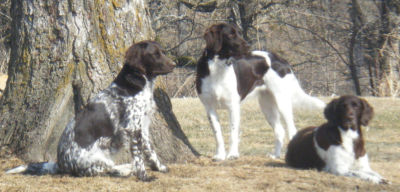 OUR MUNSTER STORY OUR MUNSTER STORYFor 40+ years, beginning with Dell's "Original Pete," we used German Shorthaired Pointers to hunt pheasant, quail, chukar, and ducks. For about 10 years we raised and trained GSPs. Then, in 2006, while researching to purchase a female GSP for breeding, Michelle ran across an advertisement for a litter of Small Munsterlander Pointers. Being completely unfamiliar with the Munster breed, Michelle began looking into them and what she found really piqued her interest. Over the next few months, Michelle did more research on the Breed and spoke with several breeders in the Midwest about the Munster's cooperative nature in the field and calm demeanor in the house. Although the GSP is an outstanding versatile hunting breed and we dearly loved our dogs, an inordinate amount of time was spent training them to consistently hunt close enough to shoot wild pheasant on the Preserve's Grasslands and they were difficult to live with in the house. Our three children had all left home for college and Michelle was very interested in a versatile hunting breed who would calmly sleep in bed and hang out on the couch with her. That Fall, we put down a deposit for a female from Gosch Kennel's litter planned for early 2007. We had third pick of females for the litter whelped on January 10th and eight weeks later we headed for western Iowa to pick up KD. We were so impressed with KD and the Munster breed that within six months of bringing KD home, we made the decision to sell our two, young, remaining GSPs and replace them with Munsters. Anna, from Riverhills Kennel, joined us in November 2007, and Gracie, from Goodman's Eagle Point Kennel, arrived in May 2008. Abi arrived in October of 2008 from Riverhills Kennel to complete our switch of breeding stock to the SM breed. Unfortunately, Gracie and Abi did not meet our high breeding standards and were sold as well-started hunters at age two. Anna delivered her B litter in January of 2011, from which we kept Tess. Anna's E Litter arrived in October of 2013, from which we kept Bella. We purchased Lizzy from Mustain Kennels in March of 2014. Unfortunately, Lizzy did not meet our high breeding standards and was sold as started hunter in 2015 to the same couple who purchased Abi from us in 2009. KD had her K Litter on October 29, 2014, from which we kept Molly. KD had her N Litter on July 1, 2015, from which we kept Nikki. Sadly, Nikki died suddenly in the Fall of 2017 from an accidental poisoning. We imported Kimber and Eve from the Czech Republic in 2016. Eve's first litter produced 3 of 7 puppies with severe overbites, so she was retired from breeding and sold to a wonderful home in Indiana at age three. Anna's U Litter arrived in August of 2017, from which we kept Mazy. Tess' V Litter arrived in October of 2017, from which we kept Grace. We kept Hazel from Molly's Z Litter whelped August 8, 2018, but she did not meet the minimum height requirement for breeding and was sold at age 8 months as a started puppy to a great home in Texas to live with a puppy from our P Litter, Penny. Eve's BB Litter arrived in February of 2019, from which we kept Claire. Sadly, Claire did not meet the minimum height requirement for breeding and was sold at age 8 months to a hunting family from Minnesota (their 3rd Brush Dale puppy!). Bella's EE Litter arrived April 23, 2019, from which we kept Hazel. Sadly, our first two Munsters, Anna and KD, both passed away in June of 2019. Tess was retired at age 8 after her CC Litter in July of 2019 and lived with our very good friend, Ginny, until she passed away in the summer of 2023. In August of 2019, we imported Eve from the Czech Republic, but she did not meet the minimum height requirement for breeding and was sold to a hunting home in Missouri at age 9 months. Molly was retired from breeding at age 6 after her GG Litter in March of 2020 and now lives in Illinois with a wonderful couple as their 2nd Brush Dale dog. Claire arrived from Grace's HH Litter in December of 2019. Mazy was never able to get pregnant and was rehomed in January of 2021 at age three. Grace's LL Litter arrived January 24, 2021, from which we kept Hope, who did not qualify for breeding due to her small size and was sold to the same family in Wisconsin who purchased Gracie about ten years prior. Bella was retired from breeding after the birth of her MM Litter in April 2021 at age 8. She is now a retired snowbird, living a life of quail hunting via golf cart right outside the backdoor of her owners' home in Arizona in the winter and wandering the mountains in Colorado in the summer. Her owners are good friends of ours and Denny has hunted with Bella at Brush Dale every year since she was born. Hazel had her first litter, the OO Litter on June 14, 2021, from which we kept Annie (namesake for her great-grandmother, Anna).
Tragedy struck for Kimber and her RR Litter in March 2022. Kimber, age 7, nearly died and seven of the eight puppies were lost. Kimber was spayed when she became septic following the emergency c-section. We kept the surviving puppy and call-named her Kim, after her mother. Unfortunately, Kim didn't meet our high standards for conformation and was sold as a started puppy. Tragedy struck again in February of 2023 and Hazel had to be euthanized after developing PLE from a lymphatic system disease at age 3. We kept Tess (namesake for her great-grandmother, Tess) from the TT Litter and Belle (namesake for her great-grandmother, Bella) from the WW Litter.
Our dogs are primarily hunted and used as guide dogs at Brush Dale Hunting Preserve, but they've also hunted a variety of wild birds in Iowa, Minnesota, Michigan, Nebraska, Missouri, New Mexico, and beyond. If you would like to see our dogs in the field, give us a call and we'll be happy to take you out onto the Preserve with our dogs. We love nothing more than "showing off" our dogs, both in the field and in the home. |

